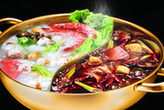Other wild plants jostle for space in the fields and add impromptu embellishment to the wealth of color that spills out over the area in symmetrical blocks. On our visit, this terrestrial scenery was accompanied by a brilliant blue sky across which puffy, white clouds meandered aimlessly. There are a dozen fantastic vantage points on a nearby mountain ridge from which to admire the bucolic beauty of Xintian. Every spot affords a different view and all are accessible via paved roads. After making a cursory tour of the area, our group decided to find a hotel, relax, and take our time to explore.
Beyond Scenic Spots The development of tourism in the region has spawned flourishing local businesses. It seems almost every household runs a shop, guesthouse or restaurant. Wandering the streets, we filled our stomachs with delicious local specialties, and emptied our wallets with souvenir shopping. Having traveled in our own car, we chose to stay in Laohua Ravine, relatively far away from the scenic area. Tucked away in a valley far from any city, we were pleased to discover our guesthouse had broadband and other modern amenities. We had a pleasant dinner of salt-cured local meat and homegrown cabbage in the guesthouse restaurant. The flavors were all natural – there’s no need for pesticides here.
We got up at five o’clock the next morning and set off to witness the sunrise from Damakan Village. We assumed with the early start we’d be the first at the nearby mountain peak, but on arriving at its base we were dismayed to see a line of cars already parked along the road. We climbed the narrow pathway to the summit and waited for sunrise in the freezing cold. The sky had been clear the previous night, but the weather had clouded over in the early morning. Finally we spotted a ray of crimson light, and everyone broke into cheers.
But the clouds seemed to be playing with us – thick one minute, dispersing the next. The crowd waited in expectation, but in the end disappointment was the mood of the morning – the sun didn’t show, and a weak crimson light was the only indication of daybreak. Dejected, we hiked back down the mountain to console ourselves with a bowl of delicious noodles with egg and vegetables.
The clouds eventually broke and in the end it was a sunny day. Walking along the mountain path we felt we were inside a painting in which the artist, in a fit of impressionism, colored the earth a spectacular rouge. Damakan Village itself boasted no official scenic spots, but spectacular scenery fanned out before us in every direction.
Rainbow Slope affords more great views. At the top of the slope is a broad platform, below which plots of colorful cropland extend into the distance. Green, gold, white and many other colors stand out starkly against the backdrop of the red earth. We sat on the platform, drinking cups of hot tea and taking in the scenery. Color was everywhere, dancing under the sunlight.
Rosy Cloud Ravine is a little higher than Rainbow Slope, and we arrived there after traversing a long, muddy path. The trek was worth it in the end: we felt as if we had discovered our very own Shangri-La. Was it really just a village and cropland? Well, yes, but the authenticity of the scene was something hard to find in China these days. The combination of color here was something that master painters have tried – and failed, we reckoned – to replicate for centuries. The only way to understand this kind of natural beauty is to see it with your own eyes.
What is true for Rosy Cloud Ravine applies to the region in general. There’s no need to search out specific scenic spots here – wherever you look, there is natural beauty worthy of a photo.
Country Life Besides falling in love with the charming scenery of Xintian, I was also won over by the “people of the red earth.” Locals here lead a traditional farming life. Whenever travelers pass by, they show a friendly, hospitable smile. They make good money thanks to the area’s fertile soil, and hence aren’t dependent on the money brought in by tourists. Many profess to be in tourism just as something “on the side.” The owner of the guesthouse in which we stayed, a local man surnamed Zhang in his 50s, said he just liked to “chat to guests.” He revealed his family had three mu (1 hectare is 15 mu) of farmland and 17 heads of cattle and goats.
The guesthouse owner told us his family leads a peaceful and happy life in Xintian. Like other local farmers, he was decked out in a bamboo hat and a cape he had made from a nylon bag. Locals recycle such nylon bags, originally used for transporting fertilizers. One recycled product is a cape like the one Zhang wore, used as protection from wind, rain and cold. The red earth on Zhang’s land didn’t stop at the entrance to his house; it was caked on his farm tools and creased into his cape. He seemed to share a bond with the land we city dwellers have lost.





Why not rent a boyfriend, or girlfriend to please parents during the Spring Festival?